The Ultimate Guide to Children Nutrition
Why Nutrition is Important
The number of overweight and obese children is growing at an alarming rate.
Almost one in three children ages five to eleven is considered to be overweight or obese.
Extra pounds put children at risk for developing serious health problems, such as heart disease, diabetes, and asthma.
Overweight children are also susceptible to emotional lability.
They are frequently teased and outcast from team activities, which may potentially lead to low self-esteem, negative body image, and ultimately depression.
Overweight and obese children have an increased risk of developing serious health problems, such as the following:
- Type 2 diabetes
- High blood pressure
- High cholesterol
- Asthma
- Bone and joint problems
- Liver and gall bladder disease
- Restless or disordered sleep patterns
- Depression and low self-esteem
In spite of these health issues, however, you can help your child reach and maintain a healthy weight with the right support, positive role modeling, and encouragement.
Healthy eating and physical activity habits are important for your child’s well-being.
I, as a mother, have always tried to take an active role to help my child learn healthy habits that last a lifetime.
This article presents a detailed explanation on how to feed your child at any age, from creating proper eating habits for toddlers, school-age children, and teenagers to mentioning some of the most common mistakes that parents make.

A healthy diet is essential for a healthy life.
Starting and maintaining a healthy lifestyle during childhood can have long-term benefits.
Having healthy eating and physical habits during the formative years of childhood greatly increases the chances that your child will continue these habits throughout life.
Statistics
Childhood obesity has been called “one of the most serious public health challenges of the 21st century” and with good reason (1).
Obesity is capable of harming nearly every system in a child’s body, including the heart, lungs, bones, muscles, kidneys, hormones controlling blood sugar and puberty, as well as the digestive tract, and can also take a social and emotional toll (2).
Children who are overweight or obese are also more likely to remain this way into adulthood, thus increasing their risk of disease and disability later in life (3).
On a global scale, it is estimated that forty-three million preschool children under the age of five were overweight or obese in 2010, which is a 60 percent increase since 1990 (4).
The problem affects both rich and poor countries.
Moreover, according to the numbers, it places the greatest burden on the poorest: of the world’s forty-three million preschoolers that are overweight or obese, thirty-five million live in developing countries.
By 2020, if the current epidemic remains unabated, 9 percent of all preschoolers will be overweight or obese, which is nearly sixty million children (4).
Obesity rates are still higher for adults, though, than children.
In relative terms, however, the U.S., China, Brazil, and other countries have been dealing with the problem of obesity rates escalating more rapidly in children than adults (5).
On the other hand, some regions still struggle with child hunger, such as Southeast Asia and sub-Saharan Africa (6).
Thanks to globalization, many regions in the world have become wealthier, and wealth and weight go hand in hand.
As poor countries gradually prosper and move up the income scale, they also tend to switch from traditional diets to Western eating habits, which trigger higher obesity rates (7).
One result of this “nutritional transition” is that low-income and middle-income countries often face two main issues: the diseases that accompany malnutrition, particularly in childhood, and debilitating chronic diseases that are related to obesity and Western lifestyles.
It is often really challenging to estimate childhood obesity rates across the world.
Many countries do not conduct nationally representative surveys that measure height and weight of school-age children.
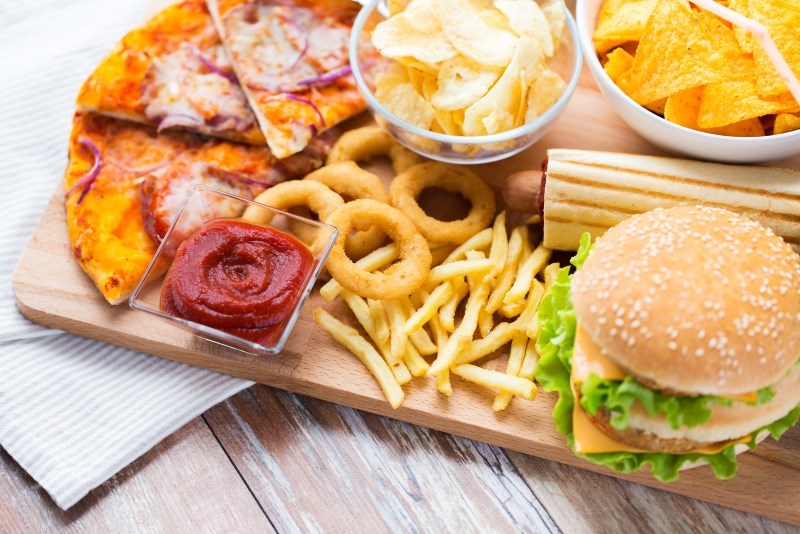
Fixing Bad Eating Habits
The first step for healthy eating is consuming a variety of whole and nutritious foods.
By consuming foods from different food groups in every meal on a daily basis, children should have a healthy and well-rounded diet.
To put it simply, a dinner plate should be divided into four different parts with fruits and vegetables comprising half of the plate and grains and proteins the other half.
Dairy products should also be incorporated into meals but in smaller amounts, whereas foods containing excess fats and sugars should become only occasional foods, eaten only once in a while.
To support continued growth and physical development, children need to satisfy their daily dietary needs, which consist of foods that will provide the nutrients necessary for growth and development, including vitamins, minerals, proteins, and complex carbohydrates.
It is recommended that children eat at least five fruits and vegetables every day.
Children who eat a healthy diet are also more likely to have faster brain development.
For instance, if children do not receive an adequate intake of iron and iodine, they may experience delays in both motor development and cognitive skills.
A child whose diet is deficient in the essential fatty acid DHA may experience difficulties and delays in learning and development.
Eating healthy foods certainly reduces the risk of health problems faced by children.
Those who eat healthy foods on a regular basis might have fewer cavities, and the root cause for many chronic diseases, such as obesity, high blood pressure, heart disease, cancer, and diabetes, can be traced back to an unhealthy childhood diet.
If children start life with healthy and whole foods, they may be able to avoid many health issues that could affect them both during childhood and into adulthood.
General Concepts of Children’s Nutrition
While most parents agree on the benefits of vegetables and healthy proteins, all other issues concerning nutrition seem to be debatable.
Should children drink fruit juice?
If yes, how much?
Is sugar acceptable in moderation?
What about high-fructose corn syrup?
While there is enough room for good parental choices in a child’s diet, a few core food groups should be included.
Most people are usually very busy and surrounded by the hubbub of daily life.
They often eat on the go, and proper nutrition is not a top priority.
Also, they easily forget the importance of their children’s nutrition.
The simplest way to test if a child should eat a given substance is to determine whether or not it is actually a food.
Any “food” that can sit on a shelf for a year and not decompose is probably not fit for consumption.
In the “nonfood” list, you may want to include anything containing hydrogenated oils (e.g., peanuts, cottonseed, vegetables, soy, and canola), anything containing high-fructose corn syrup, anything containing processed grains, anything containing MSG, and anything containing artificial sweeteners.
According to this list, you should also exclude all fast food, microwaveable food, “food” bars, and most drinks besides water from your diet.
You must also avoid chemicals in sources that are not that easily recognized, such as the BPA in canned goods, bottled water in soft plastic, or hormones, pesticides, and antibiotics found in conventional meat.
This list may be rather confusing and leave you wondering what your child is allowed to eat.
Have no worries though.
Shown below is a list of great foods that are both tasty and nutritionally rich.
They are excellent sources of necessary nutrients that every child should consume on a regular basis.
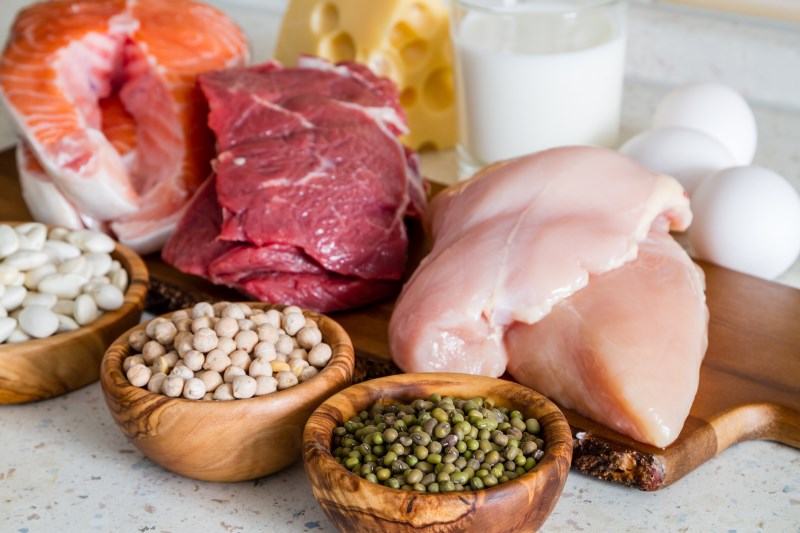
Good Sources Of Protein
Protein (amino acids) are responsible for every function in the body and absolutely vital for every person, especially those who are still in the process of forming bones and muscles.
Healthy meat offers complete proteins that children desperately need for proper growth.
I have often heard how parents complain that their children do not like red meat.
Children who rarely eat red meat often test positive for B-12 deficiency.
Regarding what constitutes healthy meat, your child should be fed meat with real, untreated, chemical-free sources of protein.
Do not buy such meat products as chicken nuggets because they are entirely unsuitable.
Instead, buy organic pure chicken, beef, turkey, and eggs, and try to have your children eat these foods every day.
Doing so will ensure that your child’s protein needs are being met.
Most children are reluctant about eating healthy meats, but once they have been well prepared, they will eat it willingly.
Proteins to eat:
- Grass-fed beef
- Organic organ meats
- Free-range chicken and other poultry
- Wild-caught fish
- Wild game and other whole proteins
- Free-range eggs
- Luncheon meats and bacon if free of nitrates and nitrites
Proteins to avoid:
- Processed meats, such as chicken nuggets
- Processed food, such as pizza and hamburgers
- Non-meats, such as soy nuggets
- Commercially raised poultry, beef, or fish
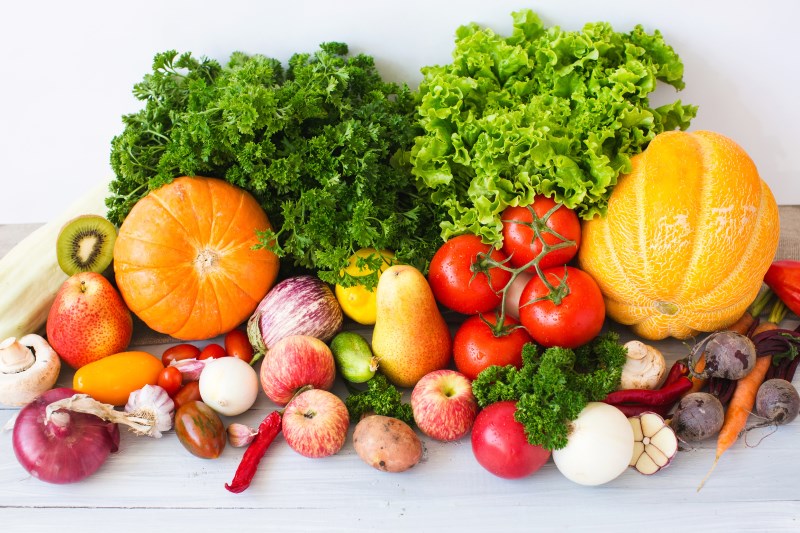
Vegetables and Fruits
Americans eat much more fruit than vegetables, and I really hope this trend will reverse.
Vegetables are equally or more important than fruit.
They are a sugar-free food, whereas fruit contains natural sugar and fructose in large amounts, which can be harmful to your child.
Moreover, in most cases, children will choose fruit over vegetables if given an option.
Many parents are willing to make this concession as long as their child is eating any healthy food.
Americans consume French fries with ketchup more than any other type of vegetable.
Even when we think we are increasing vegetable consumption by buying these happy meals, it is not the case.
Foods such as potatoes (a tuber that is high in carbohydrates and low in nutrition compared with other vegetables), corn (a grain), and peas (a legume) are not really vegetables.
Most children receive a great deal of their “vegetable” intake from tomato-based products, such as pasta sauce or ketchup, and tomato used in these products is genetically modified.
Despite all the benefits of vegetables, including reducing the risk of almost every disease, we still do not eat and feed our children enough of them.
Nonetheless, you have considerable influence as a parent. Use it.
Vegetables and fruits to eat a lot of:
- Green and leafy (e.g., spinach, kale, chard, turnips, lettuce, mixed greens, and mustard greens)
- Colorful (e.g., tomatoes, peppers, eggplant, onions, carrots, broccoli, squashes, celery, cauliflower, cabbage, berries, bananas, avocado, cucumbers, and grapes)
- Unusual (e.g., fennel, leeks, kohlrabi, asparagus, radishes, parsnips, olives, artichokes, okra, bok choy, Brussels sprouts, sea veggies, and beets)
Vegetables and fruits for treats
Instead of having sweets and soda drinks for treats at the end of a meal, turn to fruit.
I usually like to serve berries while they are in season.
My children are just “reckless” about eating berries, but most of the year vegetables come first, and fruits are served as the “dessert.”
After the period of adjustment, children come to love the natural sweetness in fruit, even more than processed sugar.
Some of the higher sugar content fruits used as great treats are:
- Apples, oranges, papaya, melons, mango, pomegranates, peaches, and pears
- Dried fruits, such as prunes, dates, dried cranberries, and prunes
Vegetables and fruits to avoid:
- Fried, such as French fries, onion rings, potato chips, and other nonfoods
- “Veggie” chips, “fruit” roll-ups, and “fruit” snacks
- Fruit juices, including the no-sugar-added juices (these are also simple carbohydrates)
- Any “fruit” or “vegetable” product that has ingredients besides fruit on the label
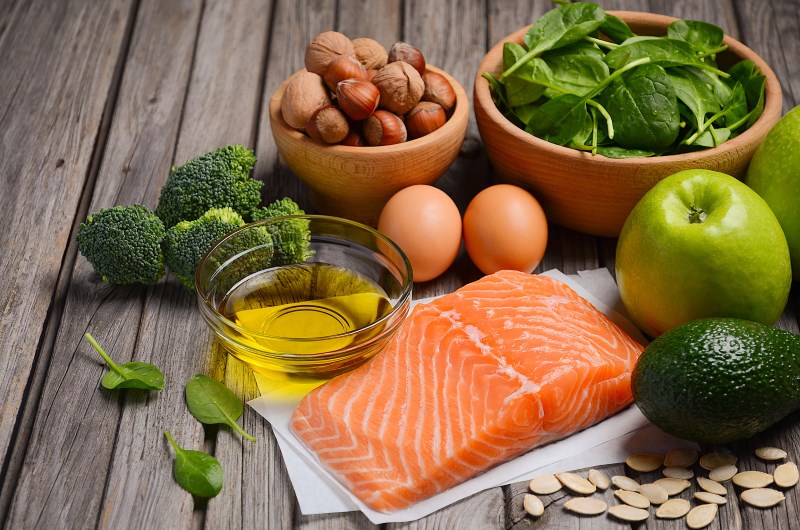
Healthy Fats
Unfortunately, the trend in low-fat food in America has been passed on to children as well.
People often go to extremes regarding diets, thinking that eating fast food or junk food gives enough room for them to eat “healthy” low-fat alternatives at other times.
Despite the best of intentions, some parents make a huge mistake by restricting fat in their child’s diet to prevent weight gain.
A restricted fat diet in children is likely to cause health problems, vitamin deficiency, and ADHD.
Dietary fats have the necessary vitamins A, D, E, and K.
For example, breast milk, which is considered the best food for babies and toddlers, is more than 50% total fat and 40%–50% saturated fat.
It is completely irrational to have your children suddenly go from a dietary need for this much fat to a much smaller need for dietary fat.
A lack of necessary dietary fats, including saturated fats, can cause a reduction in the myelin sheath, which is responsible for coating children’s brain cells.
In such cases, this may cause rapid or uncontrolled fire impulses in the brain, known as ADD or ADHD.
It may be a big step forward, but our generation really needs to stop demonizing fats.
Children under fourteen particularly need adequate amounts of fat, including saturated fat.
This intake should comprise 30% of their total diet, but be mindful in choosing healthy fats.
You do not want to consume trans fats and engineered fats, such as vegetable oils, hydrogenated oils, and shortening.
Sources of dietary fat to eat:
- Coconut (raw or shredded, flour, milk, butter as oil)
- Avocado
- Butter
- Olives/olive oil
- Ghee
- Animal sources as long as they are organic or grass fed
- Eggs
- Wild game
- Organ meats
- Fish
- Nuts
- Seeds
- Also, consider supplementing Vitamin D and Omega-3s
Sources of dietary fat to avoid:
- Polyunsaturated oils, such as liquid peanut, canola, soy, and vegetable
- Hydrogenated oils
- Trans fats
- Shortening
- Any other engineered form of oil or fat
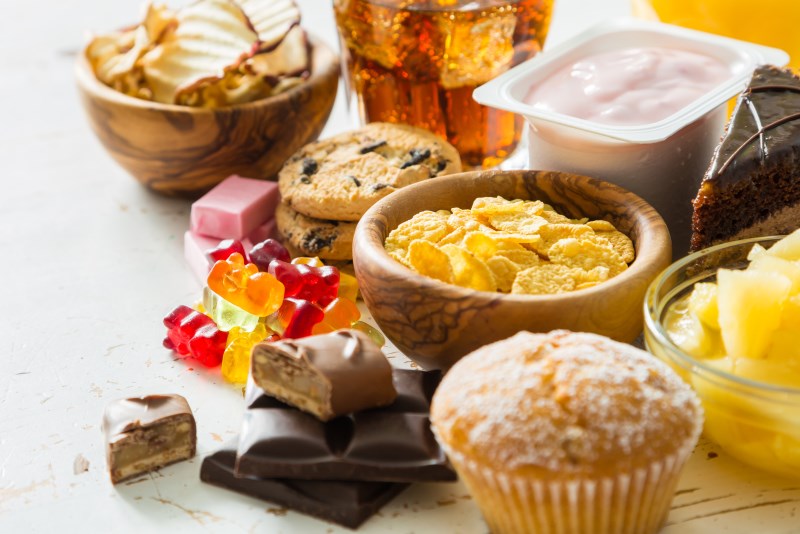
Things Children Should NOT Eat
Many parents may be wondering why there are no “healthy whole grains” and dairy products on the list.
You do not need them, and neither do your children, especially in pasteurized or processed forms, where these two food groups are associated with many childhood allergies and are not as superior in providing nutrition as they are made out to be.
My personal experience proves that children who cannot eat either of these sources due to allergies get just as many nutrients as those children who eat them on a regular basis.
Water-soluble proteins, such as lectin and gluten, which are found in grains, can be harmful to the digestive system over time.
It is also possible that these particles pass through the small intestine and end up in the bloodstream, which makes them a pathogen.
To protect itself, your body creates an immune response, and an allergy is born.
The body is capable of healing itself, however, if provided with real food, especially concerning children.
People who claim that healthy grain should be eaten for fiber and nutrients also acknowledge that meat, vegetables, fruits, and healthy fats have a much higher nutrient profile.
Nevertheless, it is recommended to avoid most whole grains, although these should still be a small part of a child’s diet.
Dairy products should not be eaten in large amounts but should be eaten in certain amounts in raw, unpasteurized forms.
Many doctors agree that dairy is a staple in many children’s diets.
Statistics indicate that children who do not eat dairy products by choice or by allergy still receive enough calcium and other nutrients (7),
But dairy products are the main source of dietary fat for many children, meaning that even though they are not necessary, they are still good to eat until this fat is replaced with some more healthy sources.
Given all the information, one may question what is the best food to feed your child.
At first, I also felt perplexed, not knowing what to give to my child.
As a new mom, it was hard to make my daughter eat things he did not like.
On the other hand, I could not imagine letting him going hungry, if only for one meal.
I started to realize how addicted to unhealthy foods he was and how resistant to healthy foods he had become.
I knew something had to change and change it did.
I decided that parents should exercise their authority over children regarding healthy eating habits, just as they exercise authority in many other aspects of their children’s lives.
Eating healthy is as important as washing your hands or going to bed early.
Even though not eating properly is more detrimental to your health than staying up late or dirty clothes, many parents are still lax on this issue.
This attitude must stop!
I decided to make the change.
If I can eat healthy, so will my child.
Much to my surprise and relief, the transition was much easier than I expected.
Although they can be picky, children are extremely resilient and adaptable.
They are more conscious about the effects of dietary improvements than adults.
Creating a healthy habit will affect your children for the rest of their lives.

How to Feed Your Baby/Toddler Healthy Food
Feeding a child can be an endless puzzle.
You know it is important that your baby eats, but he just won’t eat.
You may have many thoughts about this problem, but he knows how much he should be eating.
Yet, you will need some directions to make it easier both for you and him.
The first thing you will probably notice is a sharp drop in your toddler’s appetite after his first birthday.
Suddenly, your baby is very picky about the food he eats, refuses to come to the table, or turns his head away after just a few bites.
Many parents think now that he is active and bigger he should be eating more, but rest assured there are good reasons for the change.
His growth rate has slowed, and his body does not require as much food now as before.

Why Toddlers are Different Regarding Nutrition
A toddler generally needs about 1,000 calories a day, which is enough for growth, good nutrition, and energy.
If you have ever been on a 1,000-calorie diet, you probably know it is not much food.
A child will do just fine, however, with 1,000 calories divided into three small meals and two snacks a day.
Still, do not expect that he will always eat that way because the eating habits of a toddler are unpredictable and erratic from one day to the next.
For example, he can eat all the food in sight at breakfast but merely nothing else for the rest of the day.
Also, your child is likely to eat only his favorite food for a few days in a row and then reject it completely.
Or, he may eat 1,000 calories one day but then eat considerably more or less on a subsequent day.
The needs of your child will vary and depend on his activity level, metabolism, and growth rate.

Most Common Challenges and How to Overcome them
You should not turn mealtime into a battlefield to make him eat a balanced diet.
It is not you your child rejects.
Rather, it is the food you prepared that he turns down, so do not take it personally.
Besides, the harder you push him to eat, the less likely he will comply.
Instead, try offering him a selection of nutritious foods and letting him choose what he wants to eat.
Make sure to vary the consistency and taste as much as possible.
If it turns out that he just won’t eat anything, it might be good to save the plate for later when he is hungry, but do not allow him to fill up on sweets or cookies after rejecting his meal.
Doing so will only fuel his interest in empty-calorie foods (foods that are high in calories but low in important nutrients, such as minerals and vitamins) and diminish his appetite for nutritious foods.
It may be hard to believe, but your child’s diet will balance out over a few days in case you make a range of wholesome foods available and do not pressure him to eat a particular food at any given time.
By the age of two, your child should be eating three times a day, plus one or two snacks.
Now he is ready to eat the same food as the rest of the family.
With his enhanced social and language skills, he will be able to actively participate in mealtime conversations if given the chance to eat with everyone else.
You should work on building healthy eating habits and making healthy food choices as a family.
Sitting all together at mealtime is the beginning of a good habit.
Fortunately, your child has improved his feeding skills, meaning he can use a spoon, serve himself a wide variety of finger foods, or drink from a cup with just one hand.
Nonetheless, he is still learning to chew and swallow efficiently and is prone to gulp his food when wanting to play.
This habit increases the risk of choking, and to decrease it, avoid the following foods, which could block the windpipe if swallowed whole:
- hot dogs (unless sliced lengthwise and then across)
- nuts (especially peanuts)
- spoonfuls of peanut butter
- whole raw carrots
- whole grapes
- raw celery
- marshmallows
- raw cherries with pits
- round, hard candies or gum
Still, you should not be alarmed if your child does not always follow this ideal plan.
Many children refuse to eat particular foods or insist on eating only their favorite foods over long periods of time.
The more you oppose your child and his eating preferences, the more persistent he will be to defy you.
Offering him a variety of foods and letting him choose what to eat will eventually bring him to eat a balanced diet on his own.
He will probably find healthy foods more interesting if he can eat them on his own.
For this reason, offer him finger foods, such as raw vegetables and fresh fruits, instead of cooked ones that require a spoon or fork to eat.
Before going to school, your preschool child should have a healthy eating attitude.
Ideally, by the age of three, he no longer uses not eating or eating to display defiance.
Also, your child should not confuse food with affection or love and probably views eating as a natural response to meals and hunger.
Your child has altered his attitude toward eating, but despite his enthusiasm for eating, his preference for certain foods still remains, are very specific, and may vary from day to day.
There may be times when your child gobbles down a particular food one day but pushes away the plate with the same food the next.
He may insist on a particular food for a few days in a row and then refuse to eat it on the pretext he does not like it anymore.
Although irritating, this is normal behavior for a preschooler, and the best thing you can do is not make an issue of it.
Let your child eat the other foods on his plate or pick something else to eat.
As long as he eats foods that are not extremely fatty, salty, overly sugary, make no objections.
Still try to encourage him, however, to try new foods by offering a very small amount to taste and not by insisting that he eat an entire portion of some unfamiliar food.
If healthy options are available, let your child decide what and how much to eat.
If he is a picky eater and resists eating vegetables, for example, do not get frustrated or discouraged.
Keep offering these foods to him even if he repeatedly turns his nose at the sight of them.
It may happen that you will cause him to change his mind and develop a taste for foods that he used to ignore.
This is the right time to reinforce or establish healthy eating habits.
If healthy options are available, let your child decide what and how much to eat.
This is the right time to reinforce or establish healthy eating habits.
One of the major obstacles to good nutrition for your child is television advertising.
According to some studies, children who watch more than twenty-two hours of TV per week are more likely to become obese (8).
Children are extremely receptive to advertisements for candies and other sugary sweets.
Obesity has become an alarming problem among children in America.
Statistics show that you need to be aware of your child’s eating habits at home and away and constantly monitor him to ensure that he is eating as healthy as possible (9).

Recommended Healthy Foods
Just as you do, your toddler needs to eat foods from the same four basic nutrition groups:
- Whole milk
- Other dairy products (full-fat yogurt, soft pasteurized cheese and cottage cheese)
- Fruits (papaya, melon, apricot, grapefruit)
- Vegetables (cauliflower and broccoli, cooked until soft)
- Juice (100 percent juice, citrus and noncitrus)
- Iron-fortified cereals (wheat, oats, barley, mixed cereals)
- Protein (eggs, small pieces of meat, poultry, thinly spread peanut butter, tofu, boneless fish, beans)
- Honey
While planning your child’s menu, keep in mind that cholesterol and other fats are essential for his development and normal growth, meaning that you should not restrict these nutrients during this period.
Babies and young toddlers should get about half of their calories from fat.
You can gradually decrease fat consumption once your child reaches the age of two.
When your child is four or five, lower fat consumption to about one-third of daily calories.
I am not saying you should ignore that the number of overweight and obese children has become an alarming problem, but youngsters at the age of two really need dietary fat.
If your child’s caloric intake is around 1,000 calories a day, you should not be worrying about overfeeding him and putting him at risk of gaining too much weight.
Vitamin supplements are often unnecessary for toddlers who eat a varied and balanced diet, but your children may need supplemental iron if they eat very little meat, vegetables rich in iron, or iron-fortified cereal.
In case your child drinks a lot of milk (more than 32 ounces or 960 ml per day), it may inhibit the proper absorption of iron, which increases the risk of iron deficiency.
Sixteen ounces or 480 ml of low-fat or nonfat milk per day is just enough for your child.
This dosage will satisfy their needs for the calcium required for bone growth but at the same time not reduce their appetite for other foods, especially those providing iron.
A vitamin D supplement of 400 IU a day is of great importance for children who are not regularly exposed to sunlight, are consuming less than thirty-two ounces a day of vitamin D-fortified milk, or do not consume a daily multivitamin supplement that contains at least 400 IU of vitamin D.
This amount of vitamin D decreases the risk of rickets.
Tips
By their first birthday, children will most likely be able to handle most of the foods you serve the rest of your family but with several precautions.
First, make sure the food is cool enough so that it won’t burn the child’s mouth.
You should test the temperature yourself because your child will probably dig in without any consideration for the heat.
Moreover, do not serve your child foods that are heavily salted, sweetened, spiced, or buttered.
Such foods will prevent your child from experiencing the real and natural taste of foods they eat, which may be damaging to their long-term health.
Younger children are more sensitive to these flavorings than adults and may also reject heavily spiced foods.
Also, bear in mind that your child can still choke on chunks of food that are large enough to plug the airway.
In most cases, children do not learn to chew until they are about five years old.
At the age of two, be sure to serve them mashed foods or foods cut into small and easily chewable pieces.
Exclude whole grapes; cherry tomatoes; peanuts; sunflower or processed pumpkin seeds; meat sticks; large chunks of hot dogs; hard candies, including gummy bears or jelly beans; or chunks of peanut butter unless it is thinly spread on a piece of bread.
Carrots and hot dogs should be quartered lengthwise and sliced into small pieces.
Plus, be sure to have your child eat while seated and supervised by an adult.
Children are rather impatient, wanting to do everything at once.
“Eating on the run” is out of the question because it increases the risk of choking, and you should teach your child to finish a mouthful before speaking.
When children turn one or soon thereafter, they should drink liquids from a cup.
They will also need less milk now because solid foods will be the primary source of calories.

How to Feed Your School-Age Child
During early childhood and school-age years, a child begins to establish eating and exercise habits that stay with them for their entire life.
If a child establishes healthy habits, the risk of developing many chronic diseases will be greatly decreased.
On the other hand, establishing poor eating habits and physical inactivity during childhood increases the risk of health problems in adulthood.
Why School-Age Children are Different Regarding Nutrition
School-age children (ages six to twelve) need healthy foods and nutritious snacks.
They have a consistent but slow rate of growth and usually eat four to five times a day, including snacks.
Most food habits, likes, and dislikes are established during this period.
Family, friends, and the media (particularly TV) have a great influence on their eating habits and food choices.
School-age children are often more eager to eat a wider variety of foods than their younger siblings.
Eating a healthy after-school snack is very important, as these snacks may contribute up to one-fourth of the total calorie intake for the day.
School-age children have also developed more advanced feeding skills and are capable of helping with meal preparation.
In contrast to the rapid physical growth and development during infancy and adolescence, the childhood years (ages two to eleven) are often characterized by much slower but more stable physical growth.
On average, children gain four to seven pounds and one to four inches per year.
At approximately age ten or eleven, the growth rate once again begins to increase, which indicates the child is about to hit puberty.
Once the slower physical growth and development occurs, the body’s needs also decrease compared with infancy, especially concerning certain nutrients, such as calories and protein.
As a result, it is not uncommon to see a child with an inconsistent and decreased appetite.
On the other hand, as your child enters school and begins to participate in different school activities and organized sports events, which ultimately means an increase in physical activity, appetite and food intake will also increase.
These new activities, including starting school or participating in other structured activities, place new mental, emotional, and social demands on children.
Accordingly, the school-age years are characterized by intense development in cognitive and social skills.
Without appropriate nutrition, your child will not be able to exhibit good cognitive and physical results.

Most Common Challenges and How to Overcome them
Parents should monitor what their child eats while the child is in the best position to decide how much to eat.
Healthy and active children’s bodies know the right amount of food, even though their minds can lead them astray when choosing the right foods to eat.
The amount of food your child needs can be easily overestimated, especially during the years of middle childhood.
Children of this age do not need adult-sized servings of food, but many parents are unaware of this fact and just keep placing as much food on their child’s plate as on their own.
The child is then left to choose between being criticized for not eating everything on the plate or for overeating and increasing the risk of obesity.
Consequently, to decrease this risk, it is advisable to weigh your children occasionally, but you do not have to go too far by counting calories for your children, as most youngsters control their calorie intake quite well.
As children grow up, their energy needs will also increase as will their food intake needs, particularly as they approach puberty.
Between ages seven and ten, both boys and girls consume about 1,600 to 2,400 calories per day, even though caloric needs vary considerably even under normal circumstances.
Girls experience a significant increase in growth between ages ten and twelve and will consume about two hundred calories more each day, whereas it will take two years more for boys to experience their food intake increase, which is nearly an extra five hundred calories a day.
During the period of rapid growth, children will require increased total calorie intake and nutrients (e.g., calcium to encourage bone growth or protein to build body tissue) than at any other period in their lives.
At most ages, boys need more calories than girls, primarily due to their larger body size.
Nonetheless, appetites can vary, even on a daily basis, depending on such factors as activity levels.
A child who spends the afternoon playing outdoors may require more calories than one who spends the afternoon doing homework.
Finally, caloric needs of children vary.
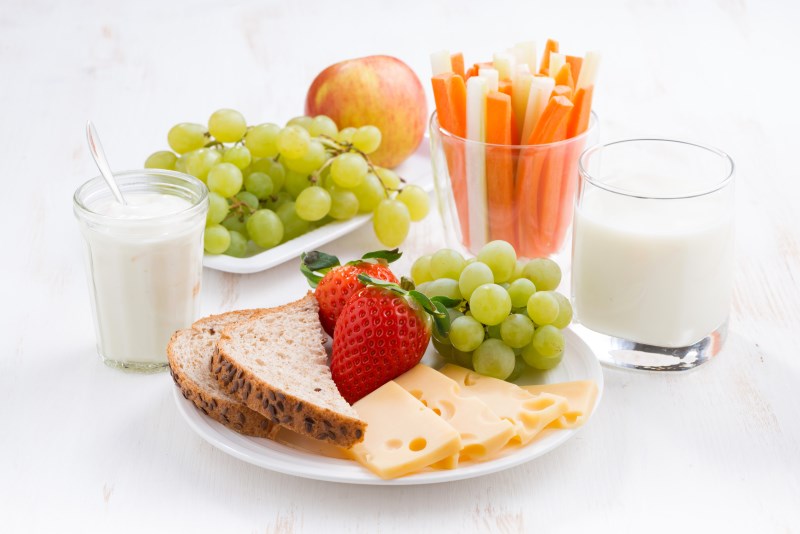
Recommended Healthy Foods
As children develop, they require the same healthy foods that adults eat, along with more minerals and vitamins to support growth, including whole grains, a wide variety of fresh fruits and vegetables, calcium for growing bones, and healthy proteins.
Here are dietary guidelines for school-age children:
- Vegetables (3–5 servings per day. A serving might contain 1 cup of raw leafy vegetables, 1/2 cup of other vegetables, raw or cooked, or 3/4 cup of vegetable juice)
- Fruits (2–4 servings per day. A serving might contain 1/2 cup of sliced fruit, a medium-size whole fruit, such as a banana, pear, or apple, or 3/4 cup of fruit juice)
- Whole grains (6–11 servings per day. A serving may include 1 slice of whole-grain bread, 1 ounce of unsweetened cereal, or 1/2 cup of brown rice)
- Protein (2–3 servings of 2–3 ounces of cooked meat, fish, or poultry per day. A serving may also include 1/2 cup of cooked dry beans, 2 tablespoons of peanut butter for each ounce of meat, or 1 egg)
- Dairy products (2–3 servings or cups per day of milk or yogurt or natural cheese)
- Zinc (Some studies indicate that zinc improves memory and school performance, particularly in boys. Good sources of zinc are beef, liver, pork, oysters, dried beans and peas, whole grains, nuts, fortified cereals, cocoa, milk, and poultry)
Tips
Here are some tips to improve your child’s nutrition and establish healthy eating habits:
- Try to control where and when your child eats food by providing regular daily mealtimes with social demonstration and interaction of healthy eating behaviors.
- Involve your child in selecting and preparing foods. Teach your child to make healthy eating choices by providing opportunities to select foods that are based on their nutritional value.
- According to one study, children, in general, do not consume enough of the following nutrients: calcium, fiber, iron, protein, and vitamins (10). For this reason, select foods that are rich in these nutrients when possible.
- Studies indicate that the number of overweight and obese children is growing (11). Consequently, it is recommended that you control portion sizes and eating processed foods, as you will limit calorie intake and increase nutrients in your child’s diet.
- Parents are encouraged to limit the amount of time children spend watching television, playing video games, and using the computer to less than two hours per day and replace such sitting activities with more active physical activities.
- Parents are encouraged to make recommended serving sizes for children.
- Sixty minutes of moderate to vigorous physical activity on most days is recommended for children and adolescents to have good health and healthy weight during growth.
- To prevent dehydration, encourage your child to drink fluid on a regular basis during physical activity and to drink a few glasses of water or other fluid after the physical activity is completed.

How to Feed Your Teenager Healthy Food
Adolescence is a period of rapid physical, intellectual, emotional, and social maturation.
To support this growth, your teenage child needs extra calories, iron, calcium, and sufficient protein.
Parents and family are now less influential on teenage eating habits, as peers, body image issues, and media messages shape their mind-set about nutrition.
Why Teenage Children are Different Regarding Nutrition
Following a period of slow growth during late childhood, teenage growth rate is as fast and rapid as that of early childhood.
By the end of adolescence, teenagers attain most of their weight and height.
Although adolescence spans a period of five to seven years, teenagers do most of their growing during an 18- to 24-month period, which is called the “growth spurt.”
To support this rapid growth, teenagers have to consume a lot of calories and other essential nutrients.
During the adolescent period, teenagers go through puberty, a process that involves total body maturation and the development of adult sexual function.
Adolescence is the period when the body composition of both males and females changes.
Before puberty, females have approximately 19% body fat, which increases to about 22% after they hit puberty.
Males, on the other hand, maintain their body fat percentage of approximately 15%, but they gain twice as much muscle mass than females during adolescence.

Most Common Challenges and How to Overcome them
By adolescence, your teenager’s eating habits are pretty much set in stone, but if these habits are based on sugary and junk foods, now is the perfect time to help them change course.
One of the best ways to get your teenagers to make dietary changes is to present ideas in terms they understand, e.g., by showing them the short-term consequences of chronically eating unhealthy foods.
Try to explain that changing and improving dietary habits and having an active lifestyle lead to a better physical appearance, better sleep, improved athletic abilities, and overall improvement in their enjoyment of life.
Say such things as “Iron will help you do your math test better and stay up late without being as tired” and “Calcium will help you grow taller during your growth spurt.”
Coax your child to engage in a 60-minute physical activity per day and make it fun.
The activity does not have to be a sport since the goal is to get your children moving in whatever makes them active and happy.
Encourage your teenager to jog, play basketball at the park, walk the dog, swim, go to the gym, or rollerblade.
Parents should watch how they coax their teenager into making these changes.
Most importantly, when parents themselves get active and eat healthier, the changes become a lifestyle habit that the children will follow.

Recommended Healthy Foods
Due to the growth spurt during adolescence, your teenager will need extra iron and calcium.
- Calcium can be found in dairy foods, so eating such foods as milk, yogurt, and cheese three times a day will provide enough calcium for your child’s body. Enough calcium will also help your child build stronger bones for life and reach peak bone density.
- Iron is necessary for your teenager. Indicators such as growing muscle mass and expanding blood volume mean that your child needs more iron in adolescence. Girls also have extra iron needs due to their periods. For example, red meat is one of the best sources of iron. Also, if your child is a vegetarian, it can help them get enough iron, but vegetarians need to eat iron-rich alternatives to meat. Some of the best sources of iron for vegetarians are green leafy vegetables; legumes, such as lentils and beans; fortified cereals; and whole grains.
Tips
- Tell them they should drink water because this is helpful for losing or maintaining a healthy weight and also keeps you refreshed and energized.
- Getting enough sleep is important because sleep deprivation has been linked with overeating. Also, sleep gives your child enough energy to move and stay awake.
- Recommend eating foods that are rich in fiber because fiber aids digestion and helps your child feel satisfied.
- Prepare a big breakfast for them. Make sure it is rich in fiber because that will help your teenager feel full throughout the day and will also save them from eating a snack, preventing empty calories from entering their body.
- Make sure they are consuming enough protein, which helps build muscle mass and strength. It also boosts metabolism, thus improving nutrition. The basal metabolic rate is increased by protein, meaning that the more protein your children eat, the more they will burn while sleeping or just sitting.
- Emphasize the importance of exercise. Your teenager does not have to train hard every day, but taking a stroll downtown would be healthy for them.
- Teach them to cook. Show them how easily they can make a simple recipe at home that is twice as healthy as other foods.
- Teach them not to trust ads. They should know it is all marketing and usually deceptive. Most of the foods that are advertised on TV are high-calorie foods that are low in nutrients.
Most Common Mistakes
Whether your child is overweight, obese, underweight, or just fine, they are still susceptible to some common mistakes that parents make.
Here are seven of these mistakes and how to avoid them:
Encouraging Children to Join the “Clean Plate Club”
Healthy young children usually eat when they are hungry and stop when they feel full.
They are led by their internal, natural cues, and you should not interfere by encouraging them to eat past the point of feeling full.
Teach your child to eat according to how hungry they feel.
Doing this will help them have a comfortable relationship with food and avoid overeating as they grow older.
According to recent studies, all children, regardless of age, are more likely to eat more when served larger portions (12).
To put it simply, the more you put food on your child’s plate, the more they will eat no matter how full they may be.
For this reason:
- Do not bribe or encourage your children to clean their plate
- Serve small to moderate portions at meals (except vegetables, which can be served to your children in unlimited portions)
- Encourage your children to eat until they feel full and comfortable with eating, and allow them to have additional servings if they request them

Offering Sweet Rewards
Some parents feel frustrated because it is hard for them to get their children to eat their vegetables, so they often resort to bribery.
“Eat your veggies and you may have donuts for dessert” is a technique that teaches our children that vegetables are less appealing and that dessert is the prize, something to be valued over other foods.
Different studies have shown that in the long-term preference for certain foods decreases when children are given rewards for eating them (13).
Depriving Children of All Sweets
Although sweets are one of the main contributors to childhood obesity, depriving your child of all sweets is an extreme measure.
To help your child have a healthy relationship with foods, you have to make a balance and meet somewhere in the middle.
There is nothing wrong with limiting sweets, but outlawing them altogether may be counterproductive.
One study has found that children who are completely restricted from eating snacks and cookies have an increased desire to eat and are more likely to eat more of them than they should whenever they get the chance (14).
It is perfectly fine to allow your child some type of dessert after dinner.
Here are some tips for choosing a dessert/snack for your child:
- Limit desserts/snacks to 150 calories (e.g., an ice-cream pop or two cookies)
- Make sure to first read labels and then choose healthy ingredients
- It is desirable to sneak in a little nutrition along with the sugar. For instance, ice cream and low-fat puddings provide calcium.
Letting Little Children Eat Like Big Children
Children with older siblings are more likely to eat junk foods (e.g., cookies, candy, cake, soda, and potato chips) than children without older siblings.
Most of their older siblings are allowed to eat these treats, meaning their little brothers and sisters tend to be exposed to unhealthy foods.
Although it is very hard to maintain the same age-based food standards for all your children, you should not let your little child get away with eating junk food just because you love them.
Allow your older children to have snacks that are not appropriate for toddlers and preschoolers.
At the same time, make sure this occurs when your youngest ones are not around.
One solution may be to put the treats in lunch boxes to take to school.
Also, consider giving sweets to your oldest when your youngest are in another room, when they go to bed at night, or when they are taking their evening bath.
Offering Too Many Snacks
If you provide your children with constant snacking throughout the day, it may leave them uninterested in eating a proper lunch.
Consequently, they will feel less hungry, thus less willing to try new foods, such as vegetables.
Therefore, you may want to:
- Allow at least two hours between meals and snacks.
- Stick to a consistent snack and meal schedule.
- Limit snacks to no more than two or three a day and about 150 calories per snack.
Getting Young Children Started on Liquid Calories
A study found that youngsters today take in 10% to 15% of their total daily calories from sugar-sweetened beverages, such as soda, fruit drinks, and sports drinks (15).
What’s more, children’s average daily calorie intake from these beverages has increased from 242 calories to 270 calories over the past ten years and continues to rise.
These drinks are packed with empty calories, meaning they are rich in sugar but low in nutrients.
Although high in calories, beverages do not trigger the same mechanisms as solid foods, meaning your children will most probably not feel satisfied from drinking soda or juice, which can result in weight gain in the long run.
To prevent weight gain from drinking beverages, limit them in your home and replace them with water, diluted 100% fruit juice, and nonfat or 1% milk.
Serving the Same Meals You Did Before Having Children
Your perfect healthy meal might include fish, plain grilled chicken, salad, and plenty of vegetables, but chances are your young children will find these foods unappealing, bland, or downright disgusting.
To persuade a picky child to try healthy foods, you will have to be a bit more creative in the kitchen.
Experiment with meals and include condiments and flavorful marinades to make bland food more tasty and appealing, or simply play around with textures, colors, or shapes to liven up the dinner plate.
Here are some ideas:
- Top vegetables or poultry, such as cauliflower, asparagus, and broccoli, with your favorite part-skim mozzarella, Parmesan cheese, or jarred marinara sauce.
- Cut fruits or vegetables into fun shapes with small cookie cutters. This works perfectly well with yellow and red bell pepper, cucumbers, raw beets, apples, melons, and pears.
- Mix grated or chopped vegetables into meatloaf, chili, soups, casseroles, marinara sauce, or other mixed dishes.
Food battles with your children can be really frustrating, but this is exactly why it is important to keep such issues as vegetable avoidance and picky eating in perspective.
Celebrate the small victories, and continue to shape healthy eating behaviors for your children.
As they get older, their healthy eating habits will be as good as they were when you insisted on them, if not better.
Ultimately, you will reap the rewards of your persistent focus on good nutrition.

Conclusion
Healthy eating habits can improve children’s overall health, sharpen their minds, stabilize their energy, and even out their moods.
On one hand, TV commercials and peer pressure for junk food make it almost impossible for children to eat well, but parents can take steps to instill appropriate and healthy eating habits without turning mealtime into a war zone.
If you encourage your children to form healthy eating habits now, it is highly likely that you will make a huge impact on their lifelong relationship with food, thus giving them the best opportunity to grow into healthy, confident adults.
Let me know in the comments if you’ve tried other strategies with your children.
FDA Compliance
The information on this website has not been evaluated by the Food & Drug Administration or any other medical body. We do not aim to diagnose, treat, cure or prevent any illness or disease. Information is shared for educational purposes only. You must consult your doctor before acting on any content on this website, especially if you are pregnant, nursing, taking medication, or have a medical condition.
HOW WOULD YOU RATE THIS ARTICLE?





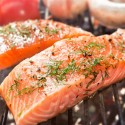

Helen, great article.. but how can i get my kinds ( 2 boys, 6 and 9 years old) eating healthy food????
It’s simply impossible….
Hello Deborah! Thank you for your feedback! You can try decorate your dishes in a funny way, or include little amount of healthy ingredients to their favorite food.
My child is lactose-intolerant, how can I compensate the lack of dairy in his diet?
Completely agree with everything you’ve written Helen. It disgusts me that so many children these days are learning poor habits from their parents. I just have to look at the other students in my child’s school to see that a vast number of those are overweight, and then you look at the parents and see why (don’t mean to be rude, but it’s true). Schools have to start placing a bigger emphasis on the nutrition of their pupils, it is SO important for their life!
I can’t deprive my daughter from unhealthy, processed foods she eats at school and children parties. How can I convince her to eat normal foods not only at home?
What desserts (health) can I cook for her?
I also experience problems making my children eat healthy. I’ve given up recently ’cause I got tired of constant fights every meal.
I thought they would understand when they grow up. But thanks to your article, I see I mustn’t let my kinds eat whatever they want so I’ll keep teaching them healthy eating habits. Now I have more ideas about what to cook!
Thanks!
I’m vegan and would like my child to keep this eating concept. But she is only 1,5 years old. Can she be a vegan? Would’t this affect her health?
My son refuses to drink plain water, all he wants is juice or ice tea…How can I make him drink water?